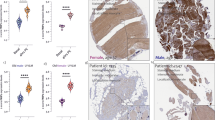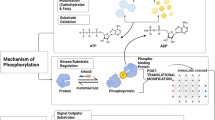Abstract
The nerve is known to play a pivotal role in the diversification of muscle fibre types postnatally. Reducing neuronal activity in a slow muscle such as the soleus by denervation, switches on genes associated with a fast muscle phenotype. On the other hand, denervating a fast muscle such as the extensor digitorum longus (EDL) induces the conversion of fast fibres to a ‘slower’ contractile phenotype. The myogenic regulatory factors (MRFs) are proposed as the regulators of muscle phenotype as MyoD and myogenin have been shown to differentially accumulate in fast and slow muscle upon the induction of fibre type transformation. The denervation model has been used in the present study to induce changes in MRF expression in the muscles of the lower hindlimb which have distinct phenotypic characteristics. The level of MRF expression in pairs of denervated and innervated soleus, EDL, tibialis anterior (TA), plantaris and gastrocnemius muscles has been determined by Northern analysis and compared. The present study has shown that each muscle responds differently to denervation with respect to the increases in MRF expression. Fast muscles responded very quickly to denervation by increasing the level of MRF transcripts while slow muscles did not show significant increases in expression after 48 h denervation. The innervated EDL (fast) and soleus (slow) muscle differed with respect to the level of MRF-4 expressed, MRF-4 being expressed at higher levels in the slow muscle compared to the fast, suggesting that MRF-4 is important in the maintenance of a slow muscle phenotype. Moreover, MRF-4 and myogenin show the greatest fold increases in expression in the fast muscles examined. MyoD and Myf 5 show less dramatic increase in expression in response to denervation but exhibit the greatest fold increases in the fast muscles compared to slow.
Similar content being viewed by others
References
Adams L, Carlson BM, Henderson L and Goldman D (1995) Adaptation of nicotinic acetylcholine receptor, myogenin and MRF4 gene expression to long-term denervation. J Cell Biol 131: 1341–1349.
Bober E, Lyons GE, Braun T, Cossu G, Buckingham M and Arnold HH (1991) The muscle regulatory gene, Myf-6, has a biphasic pattern of expression during early mouse development. J Cell Biol 113(6): 1255–1265.
Buckingham M (1992) Making muscle in mammals. Trends Genet 8: 144–148.
Buller AJ, Eccles JC and Eccles RM (1960) Interactions between motorneurones and muscle in respect to the characteristic speeds of their contraction. J Physiol 150: 417–439.
Buonanno A, Apone L, Morasso MI, Beers R, Brenner HR and Eftimie R (1992) The MyoD family of myogenic factors is regulated by electrical activity: isolation and characterization of a mouse Myf-5 cDNA. Nucleic Acids Res 20: 539–544.
Butler-Browne GS, Bugaisky LB, Cuenoud S, Schwartz K and Whalen RG (1982) Denervation of newborn rat muscle does not block the appearance of adult fast myosin heavy chain. Nature 299: 830–833.
Carraro U, Catani C and Biral D (1979) Selective maintenance of neurotrophically regulated proteins in denervated rat diaphragm. Exp Neurol 63: 468–475.
Covault J and Sanes JR (1985) Neural cell adhesion molecule (N-CAM) accumulates in denervated and paralyzed skeletal muscles. Proc Natl Acad Sci (USA) 82: 4544–4548.
Davis RL, Weintraub H and Lassar AB (1987) Expression of a single transfected cDNA converts fibroblasts to myoblasts. Cell 51: 987–1000.
Edmondson DG and Olson EN (1989) A gene with homology to the mvc similarity region of MyoD1 is expressed during myogenesis and is sufficent to activate the muscle differentiation program. Genes and Develop 3: 628–640.
Eftimie R, Brenner HR and Buonanno A (1991) Myogenin and MyoD join a family of skeletal muscle genes regulated by electrical activity. Proc Natl Acad Sci (USA) 88: 1349–1353.
Gundersen K and Merlie JP (1994) Id-1 as a possible transcriptional mediator of muscle disuse atrophy. Proc Natl Acad Sci (USA) 91: 3647–3651.
Handel SE and Stickland NC (1987) The growth and differentiation of porcine skeletal muscle fibre types and the influence of birth weight. J Anatomy 152: 107–119.
Hasty P, Bradley A, Morris JH, Edmondson DG, Venuti JM, Olson EN and Klein WH (1993) Muscle deficiency and neonatal death in mice with a targeted mutation in the myogenin gene. Nature 364: 501–506.
Hinterberger TJ, Sassoon DA, Rhodes SJ and Konieczny SF (1991) Expression of the muscle regulatory factor MRF4 during somite and skeletal myofiber development. Develop Biol 147(1): 144–156.
Hoh JFY (1991) Myogenic regulation of mammalian skeletal muscle fibres. News in Physiol Sci 6: 1–6.
Hughes SM (1998) Muscle development: electrical control of gene expression. Curr Biol 8: R892-R894.
Hughes SM, Taylor JM, Tapscott SJ, Gurley CM, Carter WJ and Peterson CA (1993) Selective accumulation of MyoD and myogenin mRNAs in fast and slow adult skeletal muscle is controlled by innervation and hormones. Development 118: 1137–1147.
Loughna PT and Brownson C (1996) Two myogenic regulatory factor transcripts exhibit muscle-specific responses to disuse and passive stretch in adult rats. FEBS Lett 390: 304–306.
Loughna PT, Izumo S, Goldspink G and Nadal-Ginard B (1990) Disuse and passive stretch cause rapid alterations in expression of developmental and adult contractile protein genes in skeletal muscle. Development 109: 217–232.
Loughna PT and Morgan MJ (1999) Passive stretch modulates denervation induced alterations in skeletal muscle myosin heavy chain mRNA levels. Pflugers Arch-Eur J Phsiol 439: 52–55.
Maltin CA, Delday MI, Baillie AG, Grubb DA and Garlick PJ (1989) Fiber-type composition of nine rat muscles. I. Changes during the first year of life. Am J Physiol 257: E823-E827.
Maltin CA, Delday MI, Campbell GP and Hesketh JE (1993) Clenbuterol mimics effects of innervation on myogenic regulatory factor expression. Am J Physiol 265: E176-E178.
Nabeshima Y, Hanaoka K, Hayasaka M, Esumi E, Li S, Nonaka I and Nebeshima Y (1993) Myogenin gene disruption results in perinatal lethality because of severe muscle defect. Nature 364: 532–535.
Pette D and Vrbova G (1985) Neural control of phenotypic expression in mammalian muscle fibers. Muscle Nerve 8: 676–689.
Rawls A, Morris JH, Rudnicki M, Braun T, Arnold HH, Klein WH and Olson EN (1995) Myogenins' functions do not overlap with those of MyoD or Myf-5 during mouse embryogenesis. Develop Biol 172: 37–50.
Rawls A, Valdez MR, Zhang W, Richardson J, Klein WH and Olson EN (1998) Overlapping functions of the myogenic bHLH genes MRF4 and MyoD revealed in double mutant mice. Development 125: 2349–2358.
Rhodes SJ and Konieczny SF (1989) Identification of MRF4: a new member of the muscle regulatory factor gene family. Genes Develop 3: 2050–2061.
Rudnicki MA, Schnegelesberg PM, Stead RH, Braun T, Arnold HH and Jaenisch R (1993) MyoD or Myf-5 is required for the formation of skeletal muscle. Cell 75: 1351–1359.
Sakuma K, Watanabe K, Sano M, Uramoto I, Sakamoto K and Totsuka T (1999) The adaptive response to MyoD family proteins in overloaded, regenerating and denervated rat muscles. Biochim Biophys Acta 1428: 284–292.
Sassoon DA (1993) Myogenic regulatory factors: dissecting their role and regulation during vertebrate embryogenesis. Dev Biol 156: 11–23.
Schuetze SM and Role LW (1987) Developmental regulation of nicotinic acetylcholine receptors. Annu Rev Neurosci 10: 403–457.
Sunderland S (1978) Traumatised nerves, roots and ganglia: musculoskeletal factors and neuropathological consequences. In: The Neurobiologic Mechanisms in Manipulative Therapy (pp. 137–166).
Swynghedauw B (1986) Developmental and functional adaptation of contractile proteins in cardiac and skeletal muscles. Physiol Rev 66: 710–771.
Voytik SL, Przyborski M, Badylak SF and Konieczny SF (1993) Differential expression of muscle regulatory factor genes in normal and denervated adult rat hindlimb muscles. Dev Dyn 198: 214–224.
Walters EH, Stickland NC and Loughna PT (2000) MRF-4 exhibits fiber-type and muscle-specific pattern of expression in postnatal rat muscle. Am J Physiol Regulatory Integrative Comp Physiol 278: R1381-R1384.
Whalen RG, Sell SM, Eriksson A and Thornell LE (1982) Myosin subunit types in skeletal and cardiac tissues and their developmental distribution. Dev Biol 91: 478–484.
Windisch A, Gundersen K, Szabolcs MJ, Gruber H and Lomo T (1998) Fast to slow transformation of denervated and electrically stimulated rat muscle. J Physiol (Lond) 510: 623–632.
Witzemann V and Sakmann B (1991) Differential regulation of MyoD and myogenin mRNA levels by nerve induced muscle activity. FEBS Lett 282: 259–264.
Author information
Authors and Affiliations
Rights and permissions
About this article
Cite this article
Walters, E.H., Stickland, N.C. & Loughna, P.T. The expression of the myogenic regulatory factors in denervated and normal muscles of different phenotypes. J Muscle Res Cell Motil 21, 647–653 (2000). https://doi.org/10.1023/A:1005683825960
Issue Date:
DOI: https://doi.org/10.1023/A:1005683825960




